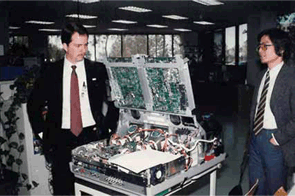Premier Mounts President Lee Dodson Finds Common Ground Among Customers And Across Markets
SCN: At the start of your career, you were a sergeant and an electronics repair technician in the U.S. Marine Corps while also holding down a civilian job as engineering group leader at Bell & Howell. What revealed your ability with electronics?
LEE DODSON : I was an EE major at San Diego State before joining the Corps, which I did primarily for the electronics training. Without a doubt, my time in the USMC was the best thing that ever happened to me. Tech school in the Corps was my first handson exposure to electronics; that school was everything I hoped it would be.
Video was still very much an art beginning its evolution into a science in the ’80s and ’90s, when Dodson worked in product management and market development roles at Sony.
SCN: Next you got away from the workbench and into product management and later market development at Sony. What did you learn from these forwardlooking roles at a time when the evolution of video was accelerating rapidly?
LD: I have to admit, to this day I miss my days on the workbench. Life was simple then. In the service department, everything you saw was broken and fixing problems was a logical process of troubleshooting, finding the fault, replacing the part(s), and realigning for best performance. When you think about it, many situations later in life are similar; the process of analyzing a problem and coming up with the best solution can take similar cues from electronic or mechanical repair.
Back then in the late ’80s everything about video as we know it now was new, so we were all learning. New developments in the technology of video presentation indicated that it would one day become a science, but for many, getting good results was still very much an art. Sony was at the forefront of this wave at the time and I had the pleasure of working with a great team that taught me much about good customer service, how to build relationships, and the AV industry—those lessons are as applicable today as they were then.
SCN: You recently became president of Premier Mounts following nearly 10 years serving as VP of marketing at Extron Electronics. From your perspective, what unique challenges does commercial AV present in terms of product positioning?
LD: Extron is one of those companies where you learn and grow at a tremendous rate. My time there has created some of the fondest memories of my career and enabled me to work with a wide variety of brilliant people. Over the past 10 years, we were able to expand into many areas of the market and also many regions of the world.
Anyone who has gained international business experience will tell you how enlightening it is to work with other cultures. It is fascinating to learn how people in other areas learn, operate, and deal with issues that are totally different than here in the U.S. Throughout every region I have worked in I came to realize that we are all more the same than we are different. The core issue facing every member of the AV industry is education. We are in a high-tech, rapidly evolving field and you either stay current to stay competitive, or find yourself left behind.
Moving over to Premier Mounts was a great move for me. Premier shares many of the same customeroriented core values as the early Sony and Extron. At Premier I have found great products, a totally customeroriented staff, and a long history of solving systems integration problems. We are working on some really neat new things that I am confident will change the way many people think about mount companies and Premier Mounts specifically. Perhaps it can be neatly summed up with our new core value statement that proudly states: Creating Positive Customer Experiences.
SCN: What role do you expect new media to play in commercial AV?
LD: As the volume of information explodes, some of the biggest problems are simply finding relevant answers. This makes creating access to our information in the places people choose to search for answers ever more useful. Video-based messaging is an obvious resource that offers much better comprehension and can be very useful for non-native English speakers.
SCN: How would you complete the following statement?
In order to keep moving forward, we must…never, never stop learning— everyone has something to teach and to learn.
